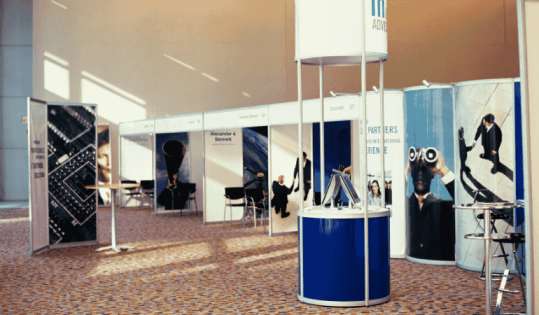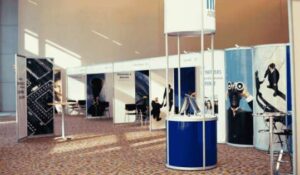Trade shows and exhibitions are great ways for businesses to show off their brand, meet new customers, and get high-quality leads. But just having a stand at an event isn’t enough. To really have an impact, businesses need to go beyond how things seem and see how well their work gets results. That’s why it’s so important to keep track of the correct KPIs for event management.
In today’s cutthroat corporate world, getting the most out of event marketing is more vital than ever. Whether you own a small business, are a marketing manager, or are a professional event planner, concentrating on meaningful event marketing KPIs will help you get more people to see your events, get them to participate, and expand your brand.
You can’t just get people to come to your event; you have to give them an experience that will stay with them long after it’s finished. To do this, you need to organize, carry out, and evaluate events in a strategic way, with success metrics at the center of everything. When businesses find and track the correct KPIs, they can learn a lot about how well an event went and use that information to make decisions that provide the best results.
A good set of event planner KPIs can help you get where you want to go. They show what’s working, point out areas that need development, and help enhance plans for future events. Keeping an eye on these indicators makes sure that your work is in line with the company’s bigger aims and gives you proof that you’re doing well. KPIs do more than just show you how much money you made. They also show you hidden trends in how people behave and what they like, which helps you plan better events in the future.
Essential Event Marketing KPIs
It’s crucial to focus on the Event KPIs that really matter if you want to get the most out of your events. You should keep an eye on these key performance indicators KPIs for event marketing:
1. Engagement of attendees
Attendee engagement is a critical indicator of trade show event success. This number shows how much people are engaging with the content of your event, the exhibitors, and other attendees. People that are engaged with your brand are more likely to remember it.
A pleasant event experience is more likely when people are highly engaged, which can make them more likely to come back for future events. People who are engaged are also more likely to tell others about your event, which will help your business reach more people than just those who attend. To get people more involved, you may add things like interactive sessions, live polls, and chances to network that encourage people to take part.
How to Measure Attendee Engagement
- Session Attendance: Keep track of how many people come to each session to see how interested they are in certain topics.
- Social Media Interactions: Keep an eye on the likes, shares, and comments on posts about the event on social media.
- App Usage: Look at the data from your event app, like how many people looked at your pages, wrote messages, and filled out surveys.
Keeping an eye on these things gives you a full picture of how people are interacting with your event. For example, the number of people who attend your sessions can help you figure out whether themes or speakers are popular with your audience. Similarly, interactions on social media can give you an idea of the bigger discourse around your event. On the other side, statistics about how people use your app might show you which features or content are most interesting, which can help you improve your plans for future events.

2. Lead Generation
Getting leads is frequently the main purpose of event marketing KPIs. This event KPI counts how many potential clients or partners you meet at the event.
Getting leads is not only about getting a lot of them; it’s also crucial to get good leads. Leads who are interested in your products or services and are more likely to become paying clients are high-quality leads. You can boost your sales pipeline and your chances of getting a good ROI from your event by paying attention to both the number and quality of leads.
How to Measure Lead Generation
- Count the number of business cards you got or the number of digital leads you got using event technologies.
- Lead Quality: Look at how likely leads are to become customers or partners to judge their quality.
To gain an accurate picture of lead quality, think about adopting a scoring system that looks at things like how interested the lead is, how much money they have, and whether they have the power to make decisions. This might help you decide which follow-up tasks are most important and make sure that your sales team is working on the best leads. Using customer relationship management (CRM) tools can also make it easier to keep track of leads and communicate better.
3. Brand Awareness
One of the main goals of event marketing is to get more people to know about your brand. This Event KPIs measures how well people recall and recognize your brand.
company awareness is more than just recognition; it’s about making people think positively about your company that sticks with them long after the event is over. Events are a great way to show off your brand’s personality and beliefs. This sets you apart from your competition and helps you establish a devoted consumer base. You may find out how your event affected how people see and think about your brand by measuring brand awareness.
How to Measure Brand Awareness
- Before and after the event, do surveys to see if brand recognition and feelings have changed.
- Media Mentions: Keep an eye on how often your brand is mentioned in news stories about the event.
Surveys may give you useful qualitative information on how people feel about your brand, and media mentions can give you a quantitative estimate of how far and how much your brand affects people. To get more people to know about your company, think about using public relations, working with influencers, and running smart social media campaigns that get your event’s word out to more people.
4. Return on Investment (ROI)
You can figure out if your event was financially successful and if it accomplished its financial goals by calculating ROI. When figuring out ROI, you should think about both direct and indirect effects. Direct benefits might be sales or leads right away, while indirect benefits might include more brand awareness, better relationships with customers, and business growth over time shows event success.
How do you measure KPI with ROI
- [ ROI (%) = \frac{\text{Net Profit}}{\text{Total Investment}} \times 100 ]
- Net Profit: Take away all of the event’s costs from all of the money it made.
- Total Investment: the total of all the costs that go into planning and running the event.
To get the most return on investment (ROI), you need to do a thorough cost-benefit analysis before the event to find possible ways to make money and save money. This way, you can carefully plan how to use your resources and make smart choices that will have the most effect on your event’s finances.
Many event professionals often ask, “how do you measure KPI effectively?” The answer lies in choosing metrics that align with your objectives, such as lead generation, attendee engagement, or revenue. By identifying which goals matter most, you can track the right data points and ensure your KPIs reflect true event success.

Advanced Event Marketing Metrics
There are advanced measures that might provide you a better picture of how well your event is doing than just the basic trade show KPIs.
5. Happy Customers
Customers that are happy with your event are more likely to come back, tell others about it, and interact with your brand in the future. Customer satisfaction is a complex measure that includes many parts of the event experience, such as the quality of the content, how well the logistics worked, and how helpful the staff was. You may improve attendees’ experiences and build long-term loyalty by understanding and meeting their demands.
How to Find Out How Happy Your Customers Are
Surveys after the event: Get feedback from participants on their experiences, such as how satisfied they were with the event’s content, logistics, and general enjoyment.
Along with surveys, you might want to use nett promoter scores (NPS) to find out how likely attendees are to recommend your event. You can find out what works and what doesn’t by looking at this data. Then you can make specific changes that will improve the experience for attendees.
6. Rate of Conversion
The conversion rate tells you how well your event turned attendees into clients or partners.
If a lot of people do what you want them to do at your event, like buy something, sign up for a newsletter, or form a partnership, then you have a high conversion rate. You can learn how well your sales and marketing are doing by looking at your conversion rate. This can help you find ways to make things better and optimise them.
How to Figure Out the Conversion Rate
[ \text{Conversion Rate (%)} = \frac {Number of Conversions}{Total Number of Attendees} \times 100
To enhance conversion rates, consider employing focused follow-up methods, such as specialised email campaigns or unique offers for attendance. Also, making sure that your sales crew is well-trained and has the right tools and information will help them turn leads into clients.
7. Social Media Reach
Social media reach shows how many people are sharing and seeing your event content.
Social media is a great way to reach more people and make your event more effective in today’s digital world. You can find out how well your digital marketing is working and where you might reach more people by looking at how far your social media posts reach. You may also learn about the kinds of material that your audience likes best by looking at your social media reach. This can help you plan future content.
How to Measure Social Media Reach
- Impressions: Count how many times your event posts show up on social media.
- Followers Gained: Keep an eye on how many new followers you get on social media before, during, and after the event.
User-generated content, influencers, and interactive campaigns that get people to share their experiences are all great ways to get the most out of social media. This can help get people talking about your event and make it more visible to more people.
Putting Effective Strategies into Action
Just knowing what these event planner KPIs are the first step. To really get the most out of your event marketing, you need to use techniques that push these numbers in the right way.
Making the Booth Experience Interesting
It’s important for marketing managers and small business owners to tell a good brand story and make their booth fun to visit. To get people’s attention and make a lasting impression, think about using interactive displays, live demonstrations, and personalised experiences.
An interesting booth experience may greatly increase brand exposure and attendee engagement. Adding things like virtual reality demos, hands-on workshops, or interactive games can make your booth stand out and make people want to spend more time there. This not only makes it more likely that people will become leads, but it also makes them feel more connected to your company.
Making the planning of events easier
Event planners may be more productive by making planning easier and making sure everyone on the team is on the same page. Typical event planner KPIs include attendee satisfaction, on-time delivery of sessions, budget adherence, and post-event survey results. These metrics give planners a clear picture of their efficiency and overall impact.
By making procedures simpler, you can use resources more efficiently and lower the chance of mistakes or miscommunication. Using digital tools for scheduling, task management, and communication can help team members work together better and make sure that everyone is working towards the same goals. This can make the event go more smoothly and make the experience for all attendees more unified.
Giving Teams People Skills
To get the most out of your encounters with guests, you need to teach your team how to conduct professionally and get along with others. To get your team ready for successful engagements, hold workshops and role-playing sessions.
Well-trained staff may make a big difference in the experience of attendees, which can lead to more happiness and engagement. You can make your workplace more friendly and professional by giving your team the skills they need to communicate well, answer questions, and solve problems. This will encourage pleasant interactions. This can help you build better relationships with people who come to the event and make it more successful overall.
Conclusion
By concentrating on the correct event marketing KPIs and employing well-thought-out plans, you can make sure that your events are not just fun but also important. To be successful in the long run, you need to keep becoming better by looking at what worked and what didn’t and making changes based on data for future events. You’ll get the most out of your investment and make your business stand out in a crowded market if you have the appropriate information.
In today’s corporate world, which changes quickly, it’s important to be flexible and dedicated to doing things well. You can turn trade fairs and events into strong instruments for growth, engagement, and enduring connections by using new ideas and data-driven analytics to measure their success.
At Exhibit Elevate, we help businesses get the most out of their trade show presence. Whether you want to get more people to know about your brand, get high-quality leads, or keep your customers loyal, we can help you make sure that your efforts are in line with measurable KPIs that will help you reach your goals.



